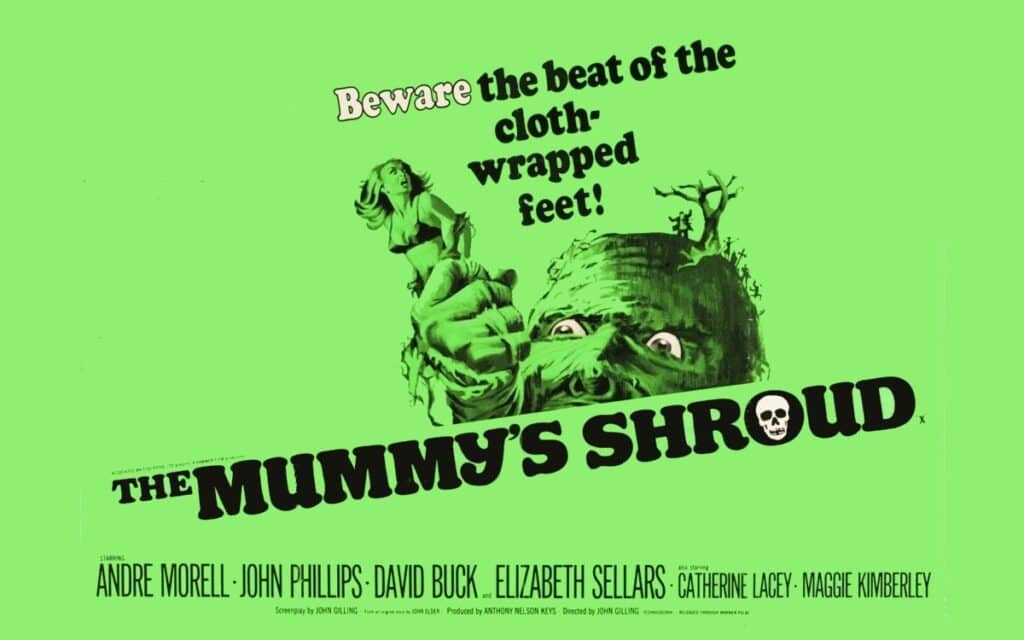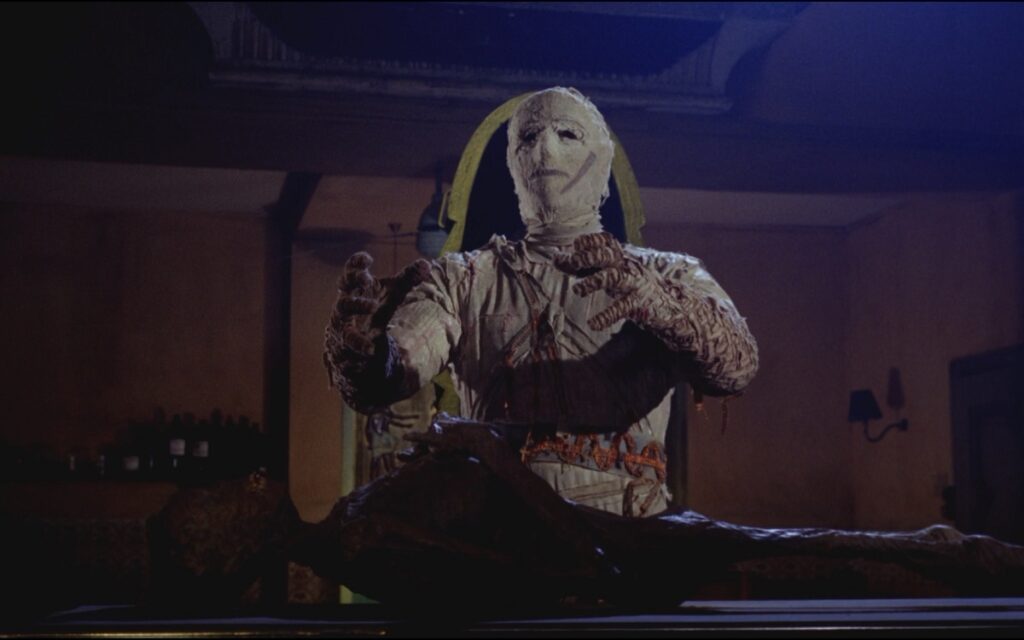Beware the beat of the cloth-wrapped feet! It was the end of an era, the last Hammer film produced at their Bray studios. RICHARD PHILLIPS-JONES revisits The Mummy’s Shroud (1967).

TITLE: The Mummy’s Shroud
RELEASED: March 15, 1967 (US), June 18, 1967 (UK)
DIRECTOR: John Gilling
CAST: André Morell (Sir Basil Walden), John Phillips (Stanley Preston), David Buck (Paul Preston), Elizabeth Sellars (Barbara Preston), Maggie Kimberly (Claire), Michael Ripper (Longbarrow), Tim Barrett (Harry Newton), Richard Warner (Inspector Barrani), Roger Delgado (Hasmid), Catherine Lacey (Haiti), Dickie Owen (Prem), Eddie Powell (The Mummy)
WRITER: John Gilling, from a story by John Elder (aka Anthony Hinds)T
Review of The Mummy’s Shroud 1967.
Ancient Egypt: The child Pharaoh Kah-To-Bey is taken away for protection by his manservant, Prem when his father is killed in a revolt at the royal palace. However, the boy dies but not before Prem has sworn to protect the boy for eternity.
Egypt in 1920: An expedition led by Sir Basil Walden and Stanley Preston finds the boy Pharaoh’s resting place. Also in the party are Preston’s son Paul, his fiancée Claire, photographer Harry and Preston’s manservant, Longbarrow.
A Bedouin named Hasmid warns them of the curse of disturbing the tomb, but the party ignores him, removing the bodies and a sacred shroud.
Inside the tomb, Sir Basil is bitten by a poisonous snake. He appears to have survived but collapses with fever upon returning to Cairo. The greedy Preston has his partner declared unstable and committed to an asylum, sensing an opportunity to take the plunder for his own gain.
Hasmid, meanwhile sets the curse into action by reviving the mummified corpse of Prem, reciting sacred words printed on the shroud. The Mummy sets out to exact revenge on all who have desecrated the Pharoah’s tomb…
Hammer’s Mummy cycle was an odd one in the company’s catalogue, since none of the films that followed their opening salvo were sequels in any way but rather variations on a theme. Indeed, it can be argued that there isn’t anything here that Hammer hadn’t already done better in The Mummy (1959), but there is a noteworthy improvement over the decidedly underwhelming The Curse Of The Mummy’s Tomb (1964).
The characters feel somewhat better realised in The Mummy’s Shroud, it’s a much better-looking production (apart from the beginning, but I’ll come onto that shortly) and the structure is also quite novel, particularly in the last half-hour which is more akin to an old-dark-house thriller in its set-up of having several characters in a relatively enclosed setting being picked off, one by one.

One can’t help feeling that it’s this element of the film which John Gilling finds most worth exploring (check out his work on The Shadow Of The Cat (1961) for an interesting comparison). By contrast, Gilling seems to have very little truck with the tortuous 8-minute pre-credits sequence (it sure as hell feels longer) which gives the audience far more of the Mummy’s back story than is really necessary.
This painfully dull prologue feels like it’s been shot in a hurry to bulk the film up to the 90-minutes required by the distributor and, quite frankly it looks cheap, the sets in this sequence ranking amongst the poorest in any Hammer production. Thankfully, you’ll miss out on very little by skipping straight to the main titles and the look and feel improve greatly once the film proper starts.
Whilst the Mummy’s costume and make-up job isn’t terribly impressive, in fairness the flaws are writ that much larger as this is an unusually brightly lit film by Hammer standards. Still, the kills are enjoyably grim (death by acid burns in a darkroom, anyone?) and the cloth-wrapped menace’s downfall is executed marvellously by the company’s regular effects boffins Les Bowie and Ian Scoones.
What really bring The Mummy’s Shroud up a notch or two are the sterling turns from the character players: Even though André Morrell is taken out of the action regrettably early, Catherine Lacey gives a delightfully manic turn as fortune teller Haiti, Roger Delgado lurks in the shadows enjoyably as Hasmid, John Philips plays Preston to such pompous perfection that you can’t wait for the Mummy to give him a good pummelling whilst the scornful looks he gets from wife Barbara (Elizabeth Sellars) speak a thousand words, summing up their marriage in a nutshell.
In particular, it’s a real treat to see Hammer mainstay Michael Ripper featured more substantially than usual, seizing the opportunity to get deep into the character of the loyal-to-a-fault Longfellow. So beloved is Ripper by Brit-horror fans that it’s hard not to get a bit choked up when he’s written out of the script, especially with the added poignancy in hindsight that this would be the last production mounted in-full by Hammer at their Bray studios.
The Mummy’s Shroud truly marks the end of an era and even if it isn’t necessarily top-drawer Hammer Horror, for that reason alone it deserves commemorating. From this point onwards, for better or worse, things at Hammer would never quite be the same.
TRIVIA POINTS: Originally released on a double-bill with Frankenstein Created Woman.
By strange coincidence, Elizabeth Sellars’ only other film for Hammer was Cloudburst, which was their very first film to be made at the Bray studio in 1951.
Dickie Owen plays Prem in the film’s prologue. He’d played the actual Mummy in The Curse Of The Mummy’s Tomb, but that part was handed here to Christopher Lee’s frequent stunt-double Eddie Powell.
There’s been some debate over the years as to whether an uncredited Peter Cushing provided the narrative voiceover at the beginning of the film. I’m not convinced personally and think the other suspected narrator, Tim Turner, more likely but you decide.
Tell us your thoughts on The Mummy’s Shroud 1967 in the comments section below!







